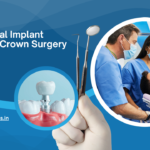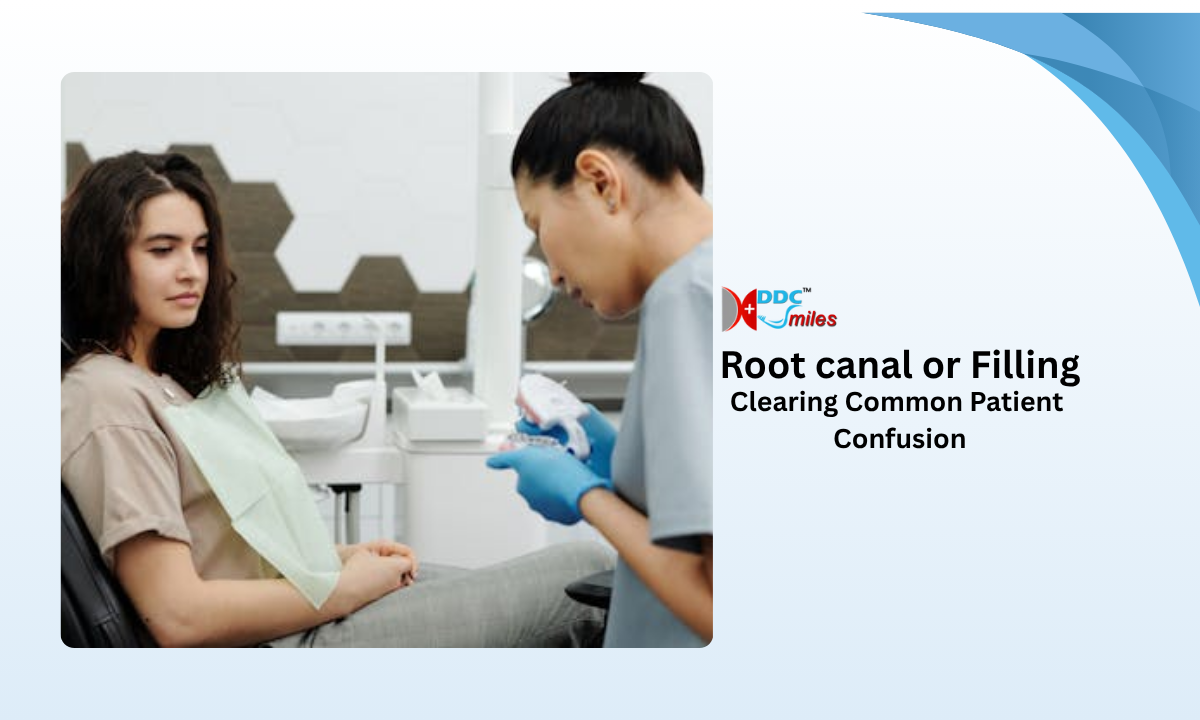When a patient asks me at DDC Smiles, “Should I go for a root canal or filling?”, I know how confusing the options can be. In many cases, tooth filling vs root canal is not a matter of preference, but a question of how far the decay has progressed, how deep the infection is, and what will preserve your tooth best.
Let me walk you through how I decide between a cavity in a tooth with a filling approach and a root canal treatment, what causes the need for a root canal, pain concerns, and when certain fillings (temporary or permanent) are useful. By the end, you will also understand how we handle these matters at our DDC Smiles dental hospital in HSR Layout and Koramangala.
When Is a Filling Enough?
If the tooth decay is moderate and hasn’t reached the pulp (the nerve and blood vessel core of the tooth), then a tooth cement filling or permanent filling for the tooth can restore the structure. Here’s how it typically goes:
- We remove the decayed portion of the tooth, clean the cavity, and then fill it with a biocompatible material (composite resin, glass ionomer, or other suitable material).
- The filling seals off the cavity and prevents bacteria from further damaging the inner layers.
- Because it’s a less invasive procedure than a root canal, recovery is quicker and discomfort is low.
However, and this is important, a filling works only when decay hasn’t penetrated deep into the pulp. If decay continues unchecked, the infection can reach the inner chamber, and that’s when we consider a root canal.
Why Is a Root Canal Needed?
A root canal becomes necessary when:
- The decay or cavity reaches the pulp (nerve) tissue and causes inflammation or infection.
- There is severe pain, sensitivity to hot and cold, swelling, or sometimes even an abscess.
- You may see a darkened tooth, or the pain becomes persistent or throbbing.
In a root canal procedure (also called root canal treatment / RCT), we:
- Administer local anesthesia.
- Access the pulp chamber and remove infected pulp tissue.
- Clean, disinfect, and shape the root canal system.
- Fill the canals (commonly with gutta-percha and sealing cement).
- Place a permanent restoration (often a crown) over the tooth to protect it.
Because the pulp (nerve) is removed, you won’t feel sensitivity or pain in that tooth afterwards. The primary goal is to save the tooth, avoid extraction, and prevent the spread of infection.
Is Filling Teeth Painful?
One of the most frequent concerns patients share with me is, “Is filling teeth painful?”
Good news: when we use local anesthesia, the insertion of a filling is usually not painful. You might feel pressure or minor discomfort, but not pain. Afterwards, some sensitivity for a day or two is normal, especially when biting or with temperature changes. In comparison, before treatment, you may already be experiencing pain because of the decay or pulp irritation.
If the decay is deep, near the pulp, then trying to do a filling alone can lead to more pain or failure because bacteria or inflammation may remain inside. In such cases, a root canal is safer and more predictable.
What Happens If You Opt for a Filling Instead of a Root Canal?
Many patients ask, “What happens if you do a filling instead of a root canal?” The answer depends on how deep the damage is:
- If the decay hasn’t reached the pulp, the filling will work fine.
- But if decay (or infection) already involves the pulp, a filling alone won’t remove bacteria or inflammation. This means the infection could persist, leading to pain, swelling, abscess, or eventually the need for extraction.
- In effect, you might waste time and money doing a filling that fails and end up requiring a root canal or extraction later.
Thus, evaluating the tooth carefully (via X-ray, clinical signs, and pulp tests) is crucial to deciding the correct treatment.
Choosing Between Root Canal or Filling: Dentist’s Perspective at DDC Smiles
When a patient visits us at DDC Smiles in Koramangala and HSR Layout, here’s how we assess:
- Clinical symptoms: pain intensity, sensitivity, swelling.
- Radiographic evaluation (X-rays): to see how far decay has progressed and whether there is periapical involvement.
- Pulp vitality tests: to see whether pulp is alive, inflamed, or necrotic.
- Structural viability: whether enough tooth structure remains to support a crown or filling.
- If the pulp is irreversibly damaged, we lean towards root canal therapy. If the infection is localized and the pulp is still viable, a filling could suffice.
At DDC Smiles dental hospital in HSR Layout and Koramangala, we offer Root Canal Treatment (RCT) using modern rotary systems and high-quality sealing materials, and we also provide durable permanent filling for teeth and restorations.
We pride ourselves on being a top dentist in Koramangala and a dentist in HSR Layout, and many patients from both areas come in specifically for endodontic care and high-quality fillings.
Conclusion
In short, a root canal or filling isn’t a matter of preference; it’s about what the tooth needs. A filling can restore a tooth with moderate decay, but when the infection has reached the pulp, a root canal is usually the safer, more predictable option. At DDC Smiles dental hospital in HSR Layout and Koramangala, we evaluate each case carefully and use the most advanced techniques to treat you with minimal discomfort and maximum long-term benefit.
If you are facing confusion over your treatment options, we at DDC Smiles are here to help you choose what’s right for your tooth, not what’s convenient.
FAQs (Frequently Asked Questions)
1. How do I know if I need a root canal or just a filling?
You’ll typically know by the severity of symptoms. A filling is enough when you have mild sensitivity, occasional tooth pain, or small visible cavities. But if pain is severe and throbbing upon biting, or you have swelling and temperature sensitivity, it likely means pulp involvement, and you need a root canal. Diagnostic tests and X-rays help confirm this.
2. Is filling better than a root canal?
Not necessarily. A filling is better only when the decay hasn’t reached the pulp. In that context, it’s less invasive, quicker, and cheaper. But if the pulp is infected, doing a filling instead of a root canal can lead to persistent problems, failure, and more invasive treatment later.
3. What happens if you do a filling instead of a root canal?
If the pulp is involved, the filling may fail to remove the infection. Over time, you’ll risk pain, abscess formation, tooth loss, or the need for a root canal or extraction later.
4. How to do a root canal for kids?
Root canals in children are more cautious. For primary (baby) teeth, we often perform a partial pulp treatment (pulpotomy) instead of a full root canal, preserving healthy pulp tissue. In permanent teeth of older children, we follow the same root canal steps—removing infected pulp, cleaning canals, filling, and restoring. The technique is adapted for size, cooperation, and tooth maturity.





